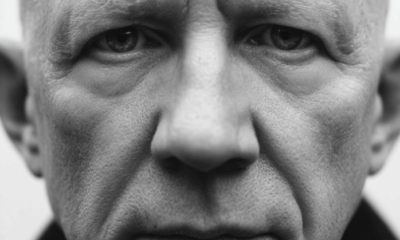Success Advice
19 Common Characteristics All Visionary Leaders Have

When you look at business leaders like Bill Gates, Sam Walton, Sir Richard Branson, and philosophers like Bertrand Russell, Martin Heidegger, Ludwig Wittgenstein, David Bohm, C. S. Peirce and inventors like Nikola Tesla, Paolo Soleri, Harvey W. Bailey, Thomas Edison, Alexander Graham Bell and Wright brothers and political leaders like Mahatma Gandhi, Martin Luther King, Jr. and Aung San Suu Kyi, it becomes very clear that they are all connected through one leadership—visionary leadership.
They might belong to different streams, but they are all visionary leaders at heart with an urge to take up leadership roles and make a difference in society.
Any leadership starts with vision followed by mission and execution. Therefore, vision becomes the bedrock of leadership. It is the first pillar that sets things in motion. Leadership alone focuses on vision not management as the latter deals with mission.
A person’s vision comes from his convictions. It comes from his passion. It comes from his values. It comes from his ethics and etiquette. Vision makes things easier and clearer for others. It clears the clutter and makes the path free from obstacles.
Visionary leadership is not conventional leadership. It is different and unique from normal leadership. The primary focus of visionary leadership is to emphasize passion and vision and subsequently on mission followed by execution for achieving organizational goals and objectives. It links from the present to the future.
Succinctly visionary leadership is all about looking into the future and predicting the future. It is all about seeing the invisible. It is being enthusiastic about uncertainty and complexity.
Here are the most common characteristics of visionary leaders.
- Visionary leaders are farsighted and always look at the implications and complications while making decisions. They go by the road less traveled. They don’t indulge in continuous firefighting as it diverts their attention from their goals. They are focused on their goals and objectives. They constantly change their strategies, styles, and approaches but not their goals.
- They take a long time to fix their goals. Once goals are fixed they commit to them through thick and thin and work towards them. They have gut feelings and follow intuition.
- They inspire others. They are attentive listeners. They facilitate teams successfully. They mobilize people towards their dreams successfully. They have the charisma to connect with their people.
- They focus keenly on the journey to reach their destination. They endeavor to be within the track so that they don’t lose sight of their destination.
- They have vision and vigor.
- They focus on long-term results, not short-term setbacks. They are highly focused on their goals.
- They lead from the front. They inspire their people and take them forward energetically.
- They are imaginative at heart. They have ideas and insights and are bold to take their people forward successfully.
- They believe in themselves. They know where they are going. They hardly care whether they are liked by others. They mind their business and their goals. They are undeterred by shocks and setbacks. They are prepared to risk their lives for the sake of their people.
- They dislike micromanaging.
- They are very clear and are highly focused. They continuously align themselves toward their goals despite external pulls and pressures.
- They are born optimists and radiate positive energy and enthusiasm.
- For them, there are no failures but only lessons.
- They take the blame in case of failure and spread the fame in case of success.
- They show visual pictures to their followers to accomplish organizational goals and objectives. Vision gives a kick to the people. It takes the people forward with energy and enthusiasm.
- They are path-makers and destiny makers
- They combine emotions to convey and communicate their goals.
- Above all, they are moral leaders who walk the talk.
What is Vision and Mission?
Vision is all about seeing the invisible through imagination. However, the mission is all about executing the activities. Vision indicates where one wants to go and mission directs how one must go.
Visionaries always look for what is possible by discovering the potential and missionaries adopt through the right planning and execution. The visionaries are directors and the missionaries are actors.
Importance of Vision and Vision Statement
Vision enhances organizational excellence and effectiveness. It enhances the commitment of employees towards the organization. It helps employees move in a specific direction in which the organization intends to move.
Vision statement is the highest order of goals that takes the organization to the tipping point. It is for the long term that can transform the organization and keep it different from others.
In contrast, the mission statement is different from the vision as it may change from time to time as the strategies to reach organizational goals and objectives change from time to time.
A vision statement serves as a catalyst. It plays a pivotal for the success of any organization. It should be clear, crisp, simple straight, and above all jargon-free. It must energize employees to contribute their best.
They must be able to take pride and be proud of the organization. There are no fixed rules and regulations and no fixed formula for crafting a better vision statement. For instance, GE’s vision statement is “To become #1 or #2 in every market we serve and revolutionize this company to have the speed and agility of a small enterprise.”
The idea of the vision statement is to ensure that all employees have one visual image of the organization connecting everyone emotionally, ethically, and energetically. Besides, it must transform with changing times and technologies.
However, the core content must remain the same and it should not be diluted because the company has been founded on fundamental ideas and ideals.
How to Craft Your Vision Statement
The vision statement must preferably be below 100 words and in the present tense to have effectiveness. It requires the imaginative mind to craft one.
We shall look at a few tools to craft a better vision statement.
- Vision must spell out a clear and compelling picture so that there is a strong reason to pursue and persevere. It must be audacious and SMART which is the acronym for specific, measurable, attainable, realistic, and time-bound.
- It should be simple and straight and challenging and inspiring.
- It must convey the company’s value system, culture, ethics, and etiquette. It should never be a mere rhetoric but must be realistic.
- It must be challenging enough so that people can put in their energies and efforts aggressively.
- It must neither be too short nor too big. It must convey the ideals and ideas of the organization for which it stands and aspires to achieve.
- Avoid jargon and buzzwords as it ensures better clarity.
When the vision statement is made to compete with another firm, the company must revise its vision once it is successful. Besides, if the company reaches the target of magical numbers then it has to revise its vision statement.
Vision helps us to get prepared today for tomorrow. It is like goal setting. As individuals set their goals, the organizations also set their goals.
It is like where they want to go. And mission serves as a roadmap to reach their vision. Succinctly mission spells out how they accomplish their vision.
Vision is closely connected with leadership. Legendary business leader, Jack Welch successfully articulated his vision and took GE to the tipping point through his visionary leadership.
To put it in the words of Peter F. Drucker, “Leadership is lifting a person’s vision to higher sights, the raising of a person’s performance to a higher standard, the building of a personality beyond its normal limitations.”
Political visionary leaders such as Theodore Roosevelt and Martin Luther King Jr have provided direction to America when needed. Besides, John F Kennedy envisioned putting a man on the moon through his visionary leadership.
To conclude, there should not be any gap between preaching and practicing to make the vision meaningful and realistic. Companies must mobilize their people around a common cause by crafting better vision statements.
The success of any company depends on its right presentation of vision statement and execution of mission statement and that is possible only through visionary leadership.
Did You Know
How Skilled Migrants Are Building Successful Careers After Moving Countries
Behind every successful skilled migrant career is a mix of resilience, strategy, and navigating systems built for locals.

Moving to a new country for work is exciting, but it can also be unnerving. Skilled migrants leave behind familiar systems, networks, and support to pursue better job opportunities and a better future for their families. (more…)
Life
10 Research-Backed Steps to Create Real Change This New Year
This New Year could finally be the one where you break old patterns and create real, lasting change.

Every New Year, we make plans and set goals, but often repeat old patterns. (more…)
Change Your Mindset
The Silent Skill That Makes People Respect You Instantly
What truly earns respect and why most people go about it the wrong way

Everybody craves respect but not everyone earns it. Some people believe that a title, years of experience, or a position of authority automatically entitles them to respect. (more…)
Entrepreneurs
The Essential Skills Every Entrepreneur Needs In 2026
Success in the digital age isn’t about luck. It’s about mastering the skills that separate dreamers from doers.

When I was 22 years old, I started my first side hustle as a ghostwriter. (more…)
-

 Change Your Mindset4 weeks ago
Change Your Mindset4 weeks agoHow to Turn Your Mind Into Your Greatest Asset (Instead of Your Enemy)
-

 Change Your Mindset4 weeks ago
Change Your Mindset4 weeks agoThe Silent Skill That Makes People Respect You Instantly
-

 Life3 weeks ago
Life3 weeks ago10 Research-Backed Steps to Create Real Change This New Year
-

 Did You Know2 weeks ago
Did You Know2 weeks agoHow Skilled Migrants Are Building Successful Careers After Moving Countries
-

 Tech3 weeks ago
Tech3 weeks agoWhat’s in a Name? How to Get Your Domain Right
















